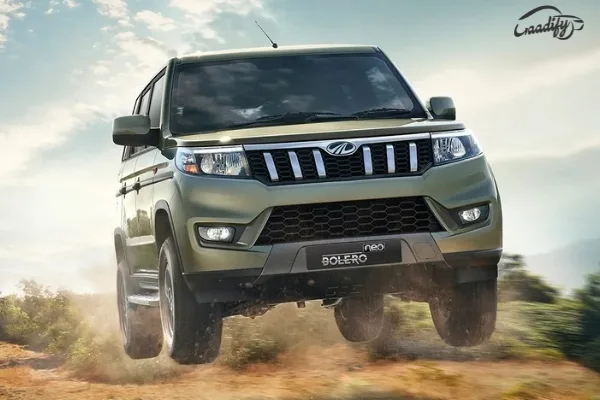Mahindra Bolero Neo has finally been launched in the Indian market at an introductory starting price of Rs 8.48 lakh (ex-showroom). It is basically a facelifted version of the TUV300 compact SUV, which was discontinued last year. But now, it will be sold as a premium alternative to the standard Bolero. The homegrown maker has offered it in four variants: N4, N8, N10, and N10 (O). Here's the variant-wise pricing: –

Also Read: Mahindra XUV700 Smart Flush Door Handles Teased
| Mahindra Bolero Neo Variants | Ex-Showroom Price (introductory) |
| N4 | Rs 8.48 lakh |
| N8 | Rs 9.48 lakh |
| N10 | Rs 9.99 lakh |
| N10 (O) | TBU |
Pricing of the top-spec N10 (O) variant will be introduced later.
Mahindra Bolero Neo – What's New?
First of all, the name 'Bolero Neo' itself is new. Considering the Bolero is one of the most successful products of Mahindra, the brand has adopted this name to change the fate of the not-so-popular TUV300 in the Indian market.

Compared to the older TUV300, the Bolero Neo gets refreshed styling, especially at the front. It features a new chrome slatted grille, revised headlamps with horizontally stacked LED DRLs, and a reworked front bumper with new fog lamps. It also carries some traditional design nods from the standard Bolero that involves a clam-shell bonnet, squared-off wheel arches, and a black plastic cladding that runs along the length of the SUV.
Besides, the new Bolero Neo also sports newly-designed silver-finished dual five-spoke alloy wheels, a new X-type spare wheel cover with ‘Bolero’ branding, and a rear spoiler. However, it misses out on the roof rails.
Also Read: Mahindra Thar Prices Upped By Up To Rs 92,000 – Biggest Hike Since Launch

Inside, the changes aren’t as extensive as the exterior. It retains a similar cabin layout and 5+2 seating configuration as the now-discontinued TUV300. However, it features a new twin-pod instrument cluster with a colored multi-information display (MID), new beige color upholstery with textured fabric seats, a new steering wheel, and an armrest for the second-row seats.

Feature highlights of the new Bolero Neo include a 7-inch touchscreen infotainment system with Bluetooth, USB & AUX connectivity, BlueSense App, steering mounted audio controls, 6-speakers, height-adjustable driver seat (manual), cruise control, air conditioning with Eco mode, rear windshield wiper with defogger, static bending headlamps with follow-me-home function, Multi-Terrain Technology, electronically adjustable ORVMs, front armrests, remote keyless entry, and more.
Passenger safety is covered by dual airbags, ABS with EBD, Cornering Brake Control (CBC), ISOFIX child mounts, speed alert system, seat belt reminder, and rear parking sensors with a reverse assist.
Also Read: Mahindra SUVs Get Costlier – Bolero, Scorpio, XUV300, XUV500, And Others
Mahindra Bolero Neo – Powertrain
The Bolero Neo continues to be powered by the same mHawk 100 1.5-liter three-cylinder diesel engine as the previous model (TUV300), albeit in a BS6 avatar. Paired with a 5-speed manual transmission, the engine makes 100PS of maximum power and 260Nm of peak torque (+20Nm than the TUV300). It also features engine start-stop technology (Micro Hybrid) and Eco drive mode for improved fuel efficiency.
Based on the 3rd-generation Scorpio's ladder-on-frame chassis, the Bolero Neo comes with a rear-wheel-drivetrain (RWD) which makes it more off-road capable than the so-called monocoque SUVs of the sub-compact SUV segment. Mahindra has also offered a mechanical locking differential with the top-spec N10(O) trim of the Bolero Neo, following feedback from customers.
Mahindra Bolero Neo – Colors
Mahindra Bolero Neo is available in a total of six body shades: Napoli Black, Majestic Silver, Highway Red, Pearl White, Diamond White, and Rocky Beige. A new Royal Gold exterior hue will join the lineup at a later stage.

Mahindra Bolero Neo – Competitors
Mahindra has positioned the Bolero Neo above the standard Bolero in Mahindra's product lineup. While it doesn't have any direct rival in the Indian market, it can be seen as a rugged body-on-frame alternative to the monocoque sub-4-meter SUVs such as the Hyundai Venue, Kia Sonet, Maruti Vitara Brezza, Tata Nexon, Mahindra XUV300, Ford EcoSport, Nissan Magnite, Renault Kiger and Honda WR-V.








